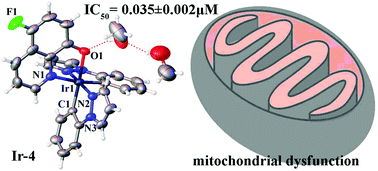Highly cytotoxic, cyclometalated iridium(iii)-5-fluoro-8-quinolinol complexes as cancer cell mitochondriotropic agents†
Abstract
Four mononuclear cyclometalated iridium(III) complexes, namely, [Ir(FQ)(L1)2] (Ir-1), [Ir(FQ)(L2)2] (Ir-2), [Ir(FQ)(L3)2] (Ir-3) and [Ir(FQ)(L4)2]·2CH3OH (Ir-4) using 5-fluoro-8-quinolinol (H-FQ)-based ligands and [(C^N)2IrCl(μ-Cl)]2 precursor have been first synthesised. The two most effective complexes (containing 7,8-benzoquinoline (H-L3) and 1-phenylpyrazole (H-L4)), Ir-3 and Ir-4, kill HeLa cells in the nanomole range, with the IC50 values of 0.170 ± 0.05 and 0.035 ± 0.002 μM, respectively, indicating that they could potentially inhibit HeLa tumour populations at a lower concentration. Encouragingly, Ir-3 and Ir-4 induce HeLa apoptosis, as indicated by the clear changes in the apoptosis-associated proteins; both accumulate to a high extent in the mitochondrial fraction; promote mitochondrial membrane (MMP) depolarisation and loss of MMP; and trigger caspase-mediated mitochondrial dysfunction apoptosis pathways. To the best of our knowledge, this study is the first to synthesize cyclometalated iridium(III)-5-fluoro-8-quinolinol complexes that can function as mitochondrion-targeting anticancer drugs.



 Please wait while we load your content...
Please wait while we load your content...